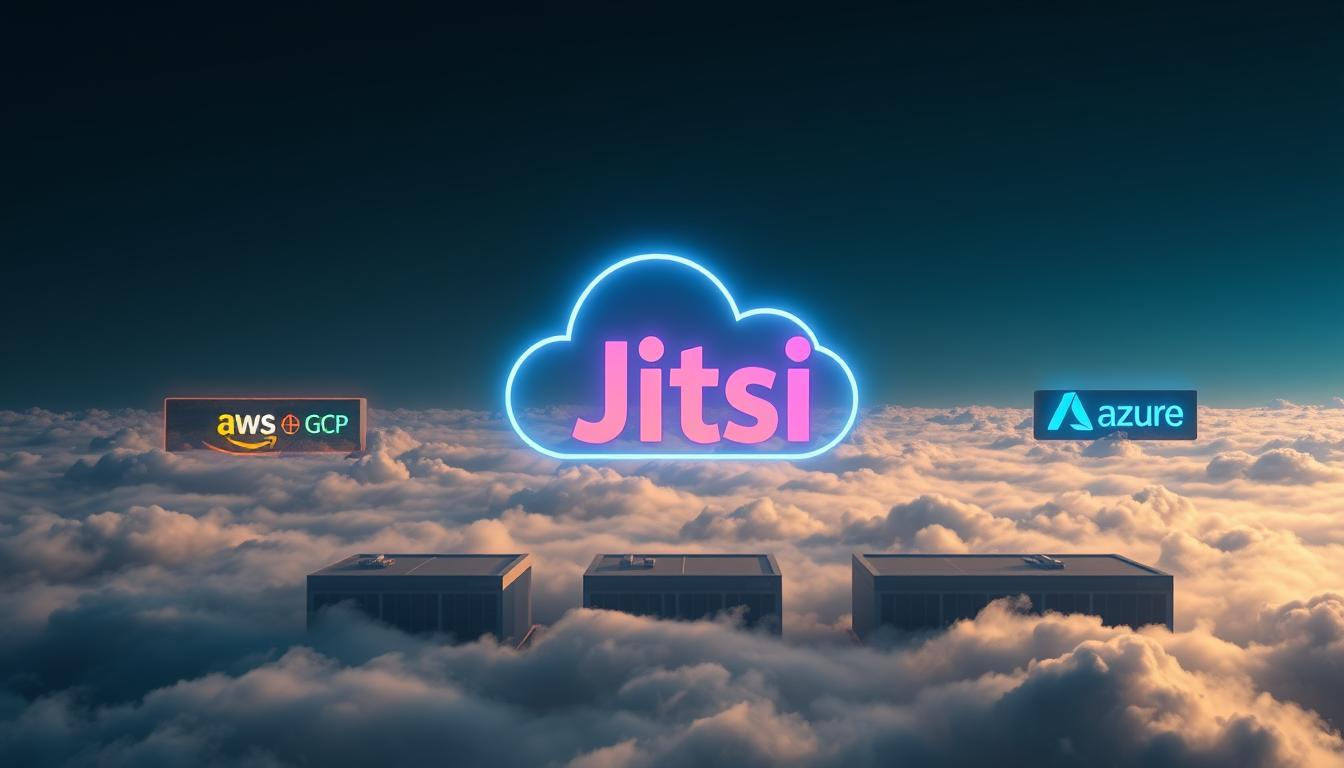Table of Contents
Ever thought about how your cloud choice affects your video conferencing? With more people working remotely, making Jitsi scale well on AWS, GCP, and Azure is key. This piece explores how to use Terraform scripts to boost Jitsi’s scalability and ease of use.
We’ll look at the good and bad of each cloud platform. Our goal is to find the top ways to improve your video conferencing for a digital workforce.
Jitsi Scaling on AWS
Jitsi Scaling on AWS uses Amazon Web Services to boost video conferencing apps. AWS offers many services like Elastic Compute Cloud (EC2) and Simple Storage Service (S3) for media. Load Balancers help spread out traffic.
Terraform makes setting up AWS resources easier. It’s a tool for Infrastructure as Code (IaC). With Terraform, scaling Jitsi is simple. It lets you add resources as needed.
High availability is a big plus for Jitsi on AWS. By setting up Jitsi in different zones, users face less downtime. This setup also handles more users without slowing down.
Here’s a table showing how Jitsi scales on AWS:
| AWS Service | Role in Jitsi Scaling |
|---|---|
| EC2 | Hosts Jitsi instances, allowing for dynamic scaling based on user demand. |
| S3 | Stores recordings and media files securely, providing scalable storage solutions. |
| Load Balancer | Distributes incoming traffic among multiple Jitsi instances for optimal performance. |
Read More: Mastering Jitsi Scaling: A Step-by-Step Guide Using Terraform on AWS
Jitsi Scaling on GCP
Jitsi scaling on GCP gives organizations a strong way to boost their video calls. It uses Google Cloud Platform’s solid setup. This lets users easily grow their Jitsi setups as needed.
Terraform is key for automating resource setup in the Google Cloud Platform. It uses an Infrastructure as a Code model. This makes it easy to set up and scale Jitsi, adapting to changing needs.
Superior Networking: GCP offers top-notch networking, cutting down on delays and making video calls clearer.
Flexible Storage: It has many storage options, making it easy to handle media and backups.
Robust Computing Power: With on-demand computing, GCP can handle lots of users at once.
Using Terraform makes things better by making infrastructure easy to manage and track. It lets companies grow their Jitsi apps easily. They get the benefits of GCP’s worldwide reach and reliable service. This means smoother video calls for everyone.
To wrap it up, Jitsi scaling on GCP with Terraform’s help is great for businesses. It helps manage real-time chats well, saving resources and money.
Read More: Scaling Jitsi Like a Pro: A Step-by-Step Terraform Tutorial on GCP
Jitsi Scaling on Azure
Scaling Jitsi on Azure means using Microsoft Azure services for better video calls. Azure Virtual Machines (VMs) help deploy Jitsi instances for fast video calls. Azure App Services make web apps scalable, working well with Jitsi for better user experience.
The Azure Load Balancer spreads traffic across Jitsi servers. This keeps service smooth and uninterrupted. Azure’s global data centers make Jitsi apps more available and responsive worldwide.
Security is key in Jitsi Scaling on Azure. Azure meets many industry standards, offering strong security for user data. This builds trust among users and organizations.
- Use Terraform scripts for easier Jitsi service deployment and scaling.
- Keep an eye on server performance to adjust resources as needed for the best experience.
- Have a backup plan to prevent data loss during scaling.
With Azure services, security, and best practices, organizations can scale Jitsi on Azure well.
| Azure Service | Function | Benefits |
|---|---|---|
| Virtual Machines | Host Jitsi instances | Flexible resource allocation |
| App Services | Run web applications | Seamless integration with Jitsi |
| Load Balancer | Distribute traffic | Improved reliability |
| Security Features | Protect user data | Compliance with industry standards |
Read More: Step-by-Step Guide Jitsi Scaling with Terraform on Azure
Comparative Analysis of AWS, GCP, and Azure for Jitsi Scaling
When looking at Jitsi Scaling on big cloud platforms, we see big differences. These differences are in how well they perform, what features they offer, their prices, and how easy they are to use. This helps companies pick the best platform for their video conferencing needs.
AWS is known for its wide range of features and strong scalability. It can handle lots of users at once, making it great for Jitsi Scaling. Its pricing might be a bit tricky, but it’s flexible based on how much you use it.
GCP shines with its machine learning and data analytics. It’s a good choice for companies wanting to use these tools for Jitsi Scaling. Its interface is easy to use, which is a big plus for new cloud users.
Azure is a good pick for companies already using Microsoft services. It makes integrating Jitsi Scaling easier because it works well with other Microsoft tools. Plus, Azure’s pricing can be good if you use a lot of Microsoft services.
| Feature | AWS | GCP | Azure |
|---|---|---|---|
| Scalability | High, supports massive scaling | Moderate, effective for medium-scale | High, native integrations available |
| Pricing Structure | Complex, pay-as-you-go options | Competitive, clear pricing tiers | Flexible, specially with bundles |
| User-Friendliness | Moderate, requires experience | High, intuitive interface | Moderate, familiar for Microsoft users |
| Performance | Exceptional load handling | Strong analytics support | Reliable with Microsoft integration |
Cost Implications of Jitsi Scaling on Different Platforms
When looking at the cost of Jitsi Scaling on AWS, GCP, and Azure, it’s key to understand each platform’s pricing. You need to watch out for hidden costs too. Knowing the total cost helps make smart choices and use resources well.
AWS charges you as you go, which can save money when usage changes. But, data transfer and storage costs can add up, mainly when you use a lot. GCP has good prices with discounts for long-term use. Yet, you should also think about API and network service costs. Azure’s pricing is based on how much you use, offering flexibility but with the risk of unexpected bills.
To keep costs down, it’s smart to manage your budget closely. Keep an eye on how much you’re using, adjust resources as needed, and use reserved instances. Knowing how AWS, GCP, and Azure charge helps you pick the best option for your budget.
| Platform | Pricing Model | Potential Hidden Costs | Cost Management Strategies |
|---|---|---|---|
| AWS | Pay-as-you-go | Data transfer, storage fees | Monitor usage, reserve instances |
| GCP | Sustained-use discounts | APIs, network services | Analyze usage patterns, automate resource scaling |
| Azure | Consumption-based billing | Networking, storage | Optimize resource allocation, budget alerts |
Performance Benchmarks for Large-Scale Video Calls
When looking at Jitsi scaling, it’s key to check performance benchmarks. These benchmarks affect the success of big video calls. Metrics like call quality, latency, and how many can join are crucial. They help decide which cloud platforms like AWS, GCP, and Azure work best.
Several factors shape these benchmarks:
- Call Quality: The clearness of audio and video is key. Low latency keeps everyone in sync, which is important in talks with many speakers.
- Latency: The delay between sending and getting audio or video signals is vital. Low latency keeps conversations smooth in big groups.
- Maximum Participants: Each platform can handle a different number of people before getting slow. Knowing this is key for big meetings or conferences.
Studies show how Jitsi does on these platforms in different situations. The results highlight big differences in handling big video calls. This can greatly affect which platforms organizations choose.
If you’re thinking about using Jitsi for big events, these benchmarks are crucial. They help plan and manage your deployment effectively.
Jitsi Autoscaling: Ensuring Optimal Performance
In today’s world of video calls, Jitsi autoscaling is vital. It helps Jitsi adjust resources as needed, keeping quality high. Autoscaling ensures a smooth experience during busy times and saves resources when it’s quiet.
To set up Jitsi autoscaling, you need to tweak Terraform scripts. These scripts make it easy to add or remove resources based on demand. This way, you can scale up during busy times and save money when it’s slow.
For a good Jitsi autoscaling setup, you need a few key things:
- Load thresholds to start scaling.
- Health checks to make sure servers are working right.
- Scaling policies to know when to add or remove servers.
Using these strategies, you can make your video calls better. This means your calls will always run smoothly, no matter how many people are joining.
| Scaling Factor | User Load | Action to be Taken |
|---|---|---|
| Low | 1-10 | Maintain minimum server instance |
| Medium | 11-50 | Scale up to 2 instances |
| High | 51-100 | Scale up to 5 instances |
Following these tips will greatly improve your Jitsi video calls. Autoscaling is key to meeting user needs and keeping communication top-notch.
Conclusion
Scaling Jitsi on platforms like AWS, GCP, and Azure is key for better remote work. Each cloud has its own benefits and hurdles. It’s important to pick the best one for your needs to ensure smooth video calls.
Using Terraform scripts makes setting up Jitsi easier and more consistent. As remote work grows, it’s vital to choose the right cloud for Jitsi. This choice affects how well remote teams work together.
The platform you choose matters a lot. A strong Jitsi setup helps remote teams work better. It keeps communication flowing and works productively in our digital world.
FAQ
Jitsi works on many cloud platforms like AWS, GCP, and Azure. Each one has its own benefits for setting up video calls.
Jitsi autoscaling adjusts resources based on how many users are online. It keeps meetings running smoothly, even when lots of people join.
To scale Jitsi on AWS, use Terraform scripts. They help manage resources like servers and storage. This makes video calls reliable and fast.
To check video call quality, monitor things like call quality and how many people can join. Regular checks help keep meetings smooth.



